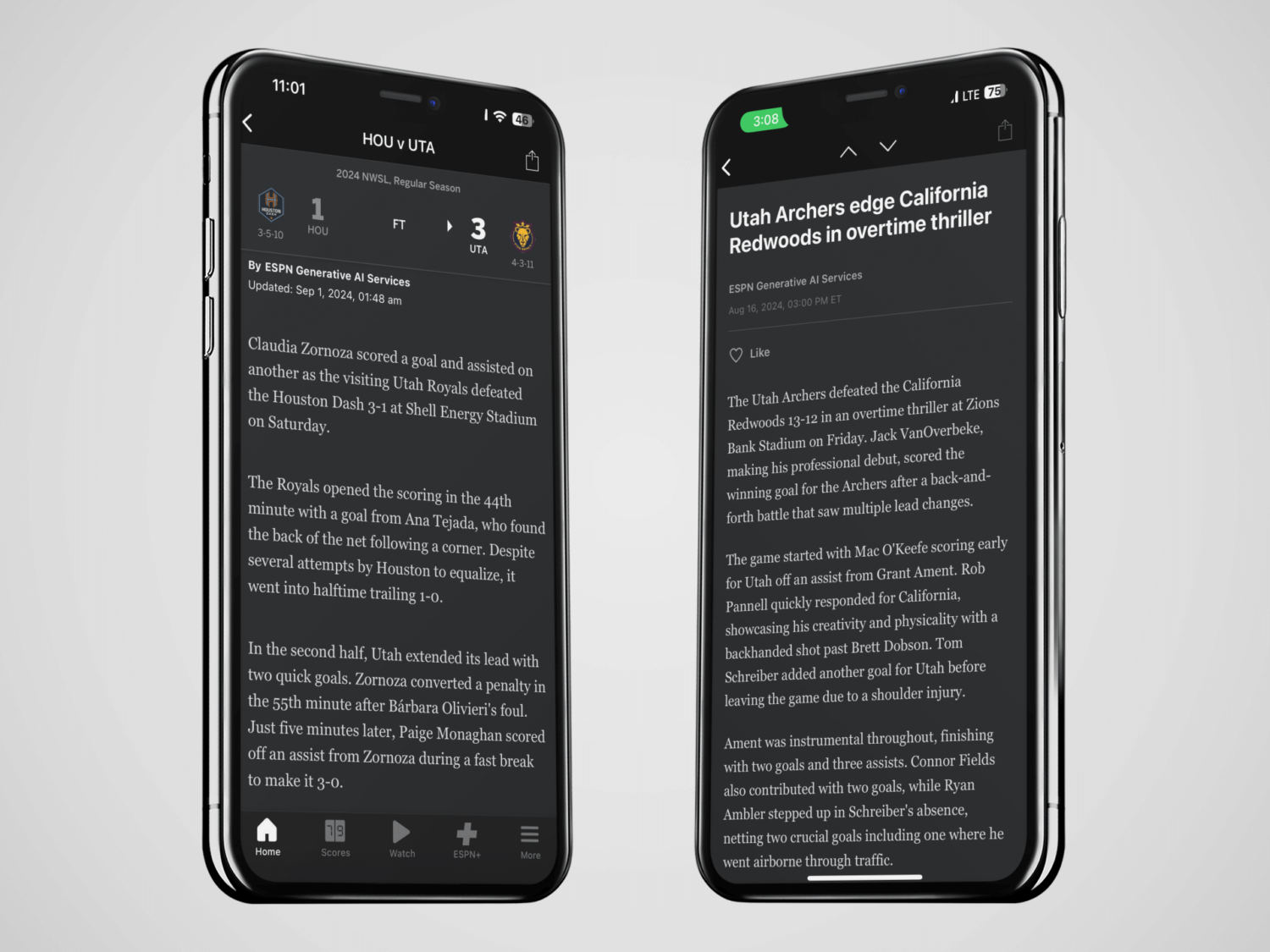ESPN made a major announcement on Thursday. The sports media giant announced it would implement artificial intelligence to write game recap stories for the Premier Lacrosse League and National Women’s Soccer League.
As with anything involving the rapidly changing alliance of AI and journalism, what followed were lots of questions and a little uneasiness.
ESPN is making the case that AI helps it cover “under-served sports” — leagues that ESPN currently does not fully cover with flesh-and-blood sportswriters. In other words, this argument seems to be that using AI to cover sports or leagues is better than not covering them at all.
On the other hand? The fear among living and breathing journalists that this is a slippery slope, and that AI is taking their jobs. They say: Instead of using AI to write lacrosse and soccer stories, why doesn’t ESPN just hire more journalists? And if ESPN can use AI to cover those sports, what’s to stop them from using AI to cover more and more other sports?
In its announcement, ESPN laid out the crux of its argument: “The AI-generated recaps aim to enhance coverage of under-served sports, providing fans with content that was previously unavailable. These sports do not currently have game recaps on ESPN digital platforms, and these AI-generated recaps will be a tool to augment existing coverage — not replace it.”
ESPN added, “Each AI-generated recap will be reviewed by a human editor to ensure quality and accuracy.”
ESPN also announced that it will be clear which stories were generated by AI. The top of the story, where the traditional byline would be, will say, “ESPN Generative AI Services.” After the story, there will be a tagline that says, “ESPN Generative AI Services creates recaps from event data and/or transcripts that are reviewed by human editors before posting; email support@espncustomercare.com for corrections.”
The new plan will go into effect today.
ESPN said in its statement, “The aim is to learn, determine how to responsibly leverage new technology, and begin to establish best practices — all while augmenting our existing coverage of select sports and allowing ESPN staff to focus on their more differentiating feature, analysis, investigative, and breaking news coverage.”
That last part is an argument that many in the journalism world point to when considering the benefits of AI: that the use of the technology to write simpler articles, such as a game story, frees up their journalists to work on bigger, so-called “more important” stories.
At ESPN’s recent “Media Day” meeting with reporters, ESPN chairman Jimmy Pitaro said, “AI is not the awful, terrible disruptor that many people think it will be. I personally believe that AI will be very helpful and beneficial to the sports industry and the sports fan, and we’re starting to see that.”
Pitaro gave examples of using the technology to cut highlights of, again, lesser-covered sports. Pitaro also talked about closed captioning, saying, “How do we do closed captioning at scale? AI is already helping us significantly there. I commute. I drive myself to Bristol every day. It’s an hour drive for me each way. And I want to consume our long-form reporting, our investigative reporting, which is super high quality. Having the ability to just click play and hear the narration of a long-form investigative story is incredibly valuable to me as a commuter. Those are some examples of how we see this as nothing but positive for the sports fan and for the business.”
ESPN is not the first news organization to implement AI this way. Front Office Sports’ Margaret Fleming notes that The Associated Press uses AI.
An AP spokesperson told Fleming, “AP uses artificial intelligence and automation when it can free up our journalists to do more meaningful work. We use AI to produce audio-to-text transcriptions, create short lists in predictable environments, tag content for search, and write corporate earnings reports and some sports preview and recap stories. We also use automation for the distribution of financial markets and sports data.”
But all this still makes some in the journalism world queasy.
Besides doing a job that has always been for actual journalists, AI is not known for writing particularly captivating stories.
In a column for Defector, Luis Paez-Pumar wrote, “The upshot would be that ESPN is beefing up its coverage of ‘underserved’ sports (and who, pray tell, is responsible for this underserving?) not by hiring people who can and already do write these kinds of stories, but rather by feeding existing soccer and lacrosse journalists’ work into a machine aimed at making them obsolete. Or, at least, it will try to make them obsolete; nothing about AI’s recent history points to this being successful in any way except fattening the wallets of AI’s self-interested investor-evangelists.”
The AI train continues to plow forward, and ESPN is clearly jumping aboard. Used responsibly and judiciously, AI could be a helpful and worthwhile tool for any media company without being a detriment to real journalists. But if the real goal is to simply save money by using AI, particularly when it’s an inferior product to a reasonably good journalist, it’s hard to get on board if you’re a media consumer.
I’m willing to give ESPN the benefit of the doubt when it comes to using AI to cover sports leagues they have never really covered. But is this really just a trial balloon? If so, let’s see what comes next before we declare this a good or bad idea.
Sulzberger’s powerful essay
New York Times publisher A.G. Sulzberger wrote a powerful essay Thursday about the “quiet war” against press freedoms in the United States. And he wrote his lengthy piece for, of all places, the Times’ chief competitor — The Washington Post. More on that decision in a moment.
But let’s get to what Sulzberger wrote.
Sulzberger asks if the playbook used by Hungarian Prime Minister Viktor Orbán to dismantle the news media in his country could be repeated here.
Sulzberger wrote, “It’s not a crazy question. As they seek a return to the White House, former president Donald Trump and his allies have declared their intention to increase their attacks on a press he has long derided as ‘the enemy of the people.’”
He added, “If Trump follows through on promises to continue that campaign in a second term, his efforts would likely be informed by his open admiration for the ruthlessly effective playbook of authoritarians such as Orbán, whom Trump recently met with at Mar-a-Lago and praised as ‘a smart, strong, and compassionate leader.’”
Sulzberger said he and colleagues have studied how press freedoms have been attacked in places such as Hungary, India and Brazil. The countries may be different, but the playbooks are the same. They include things such as sowing distrust in the media; normalizing harassment of journalists; exploiting the courts to, as Sulzberger wrote, “effectively impose additional logistical and financial penalties on disfavored journalism;” and, again as Sulzberger wrote, “use the levers of power not just to punish independent journalists but also to reward those who demonstrate fealty to their leadership.”
That certainly sounds familiar in this country under a certain former president.
Sulzberger wrote, “As that list makes clear, these leaders have realized that crackdowns on the press are most effective when they’re at their least dramatic — not the stuff of thrillers but a movie so plodding and complicated that no one wants to watch it.”
Sulzberger made it clear that it is not his intention to wade into politics, adding, “I disagree with those who have suggested that the risk Trump poses to the free press is so high that news organizations such as mine should cast aside neutrality and directly oppose his reelection. It is beyond shortsighted to give up journalistic independence out of fear that it might later be taken away.”
He later added, “At the same time, as the steward of one of the country’s leading news organizations, I feel compelled to speak out about threats to the free press, as my predecessors and I have done to leaders of both parties. I am doing so here, in the pages of an esteemed competitor, because I believe the risk is shared by our entire profession, as well as all who depend on it.”
This is an important essay that cannot be adequately summed up here. Carve out 20 minutes to read it.
Meanwhile, Sulzberger addressed why he offered his piece to the Post in a memo to his staff at the Times, writing, “I’m grateful to The Post for running it, especially given the length. It’s just another example of how The Post, in addition to being an esteemed competitor, has long been one of our closest partners on matters of press freedom. These challenges cannot be solved by one institution.”
And now for more media news, tidbits and links for your weekend review …
- Rules for next Tuesday’s presidential debate on ABC have been set. Like the debate between Donald Trump and Joe Biden, microphones will be muted when it is not a candidate’s turn to talk. There will be no audience. It will be 90 minutes in length, including two breaks. The debate will be moderated by “World News Tonight” anchor David Muir and ABC News Live “Prime” anchor Linsey Davis.
- For the Columbia Journalism Review, Jake Lahut with “The decline of local news has become a campaign problem.”
- The New York Times’ Santul Nerkar with “How Media Outlets on the Left and Right Covered Trump’s Arlington Cemetery Visit.”
- Semafor’s Ben Smith with “Blaze fires contributor linked to alleged Russian operation.”
- CNN’s Hadas Gold with “The Murdoch family is secretly battling over succession. News outlets are asking a court to make it public.”
- CNN’s Brian Stelter with “White House condemns Tucker Carlson’s ‘Nazi propaganda’ interview as ‘disgusting and sadistic insult.’”
- Time magazine with “The 100 Most Influential People in AI 2024.”
- Here’s the content that we’re here for. The Athletic’s Alex Andrejev with “How many Chiefs games will Taylor Swift attend in 2024? How her tour schedule aligns.”
- LaSharah S. Bunting, the current CEO and executive director of the Online News Association, is joining The 19th as its first vice president. Here’s more from The 19th.
- Ahead of the release of the film “Beetlejuice Beetlejuice,” The Ringer’s Miles Surrey with “I Watched ‘Beetlejuice’ for the First Time. I Have Questions — 14 of Them.”
More resources for journalists
- Applications are due today for Power of Diverse Voices.
- Public media journalists: Applications for our Digital Transformation Program close today!
- Are you an upcoming-and-coming newsroom manager?
Have feedback or a tip? Email Poynter senior media writer Tom Jones at tjones@poynter.org.
The Poynter Report is our daily media newsletter. To have it delivered to your inbox Monday-Friday, sign up here.







